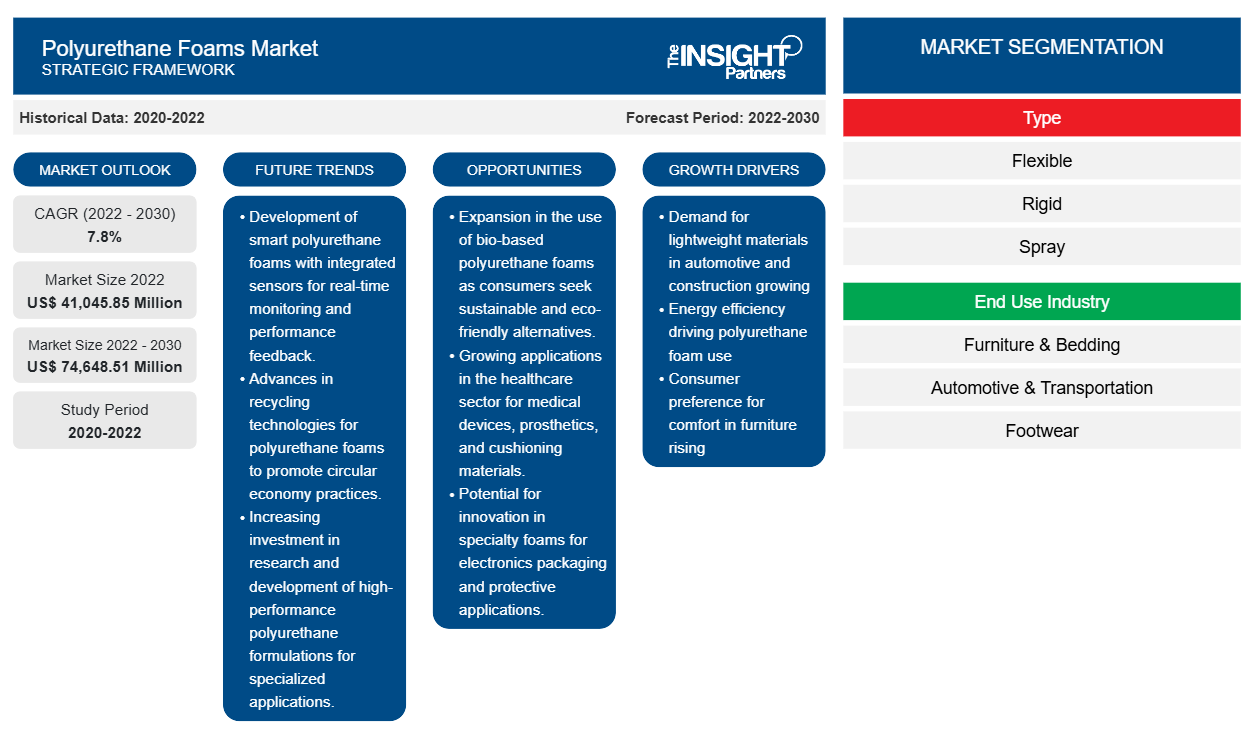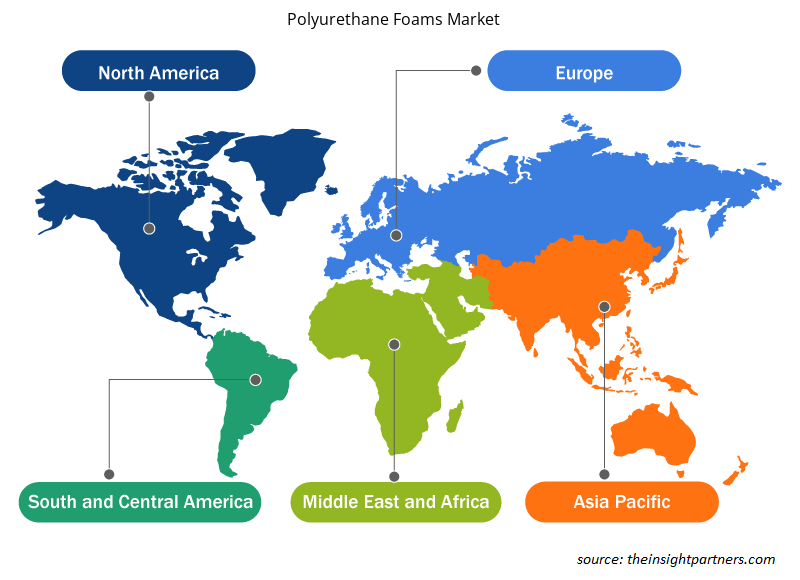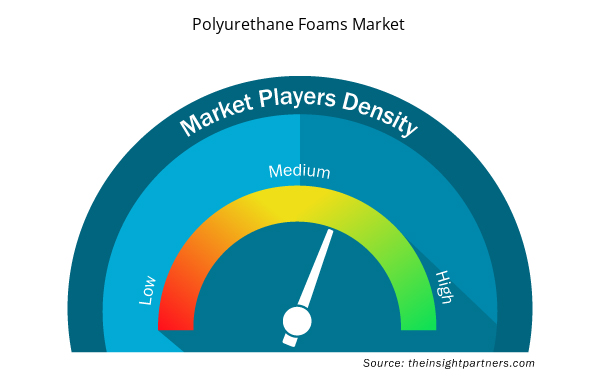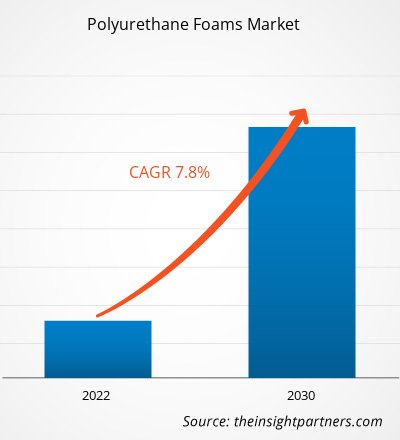[Research Report] The polyurethane foams market size was valued at US$ 41,045.85 million in 2022 and is expected to reach US$ 74,648.51 million by 2030; it is estimated to register a CAGR of 7.8% from 2022 to 2030.
MARKET ANALYSIS
Polyurethane foams, renowned for their versatility and adaptability, are a class of polymers created through the reaction of polyols and diisocyanates. The polyurethane foams market has experienced significant trends in recent years, driven by a combination of technological advancements and evolving consumer demands. Additionally, the demand for lightweight and high-performance materials in industries such as automotive and construction spurred innovations in polyurethane foam formulations. This chemical marriage results in a material that boasts a spectrum of physical and chemical properties suitable for diverse applications. Flexible and rigid are two primary categories of polyurethane foams. Flexible foams, notable for their resilience and comfort, find extensive use in products such as upholstered furniture, mattresses, and automotive seating. Their ability to contour to body shapes ensures comfort and durability. The market has also witnessed a rise in flexible foam applications, particularly in bedding and furniture, owing to their comfort and durability. Moreover, stringent regulations regarding energy efficiency and building standards have stimulated the adoption of polyurethane foams for insulation purposes. However, rigid polyurethane foams excel in insulation, playing a pivotal role in the construction industry to enhance thermal efficiency in buildings. All the above-mentioned factors impact the polyurethane foams market significantly.
GROWTH DRIVERS AND CHALLENGES
Polyurethane Foams are used in a variety of applications in the automotive industry. In modern vehicle interiors, manufacturers increasingly rely on polyurethane foam to create ergonomic and comfortable seating solutions. Luxury car models from reputable brands feature seats with polyurethane foam padding, providing optimal support and comfort for occupants during extended drives. This exemplifies the foam's integral role in enhancing the overall driving experience. Moreover, advancements in automotive safety have seen a surge in the incorporation of polyurethane foam in impact-absorbing components. Recent crash test results and safety ratings of new car models underscore the strategic use of polyurethane foam in designing energy-absorbing structures within vehicles, mitigating the impact forces during collisions and thereby enhancing occupant safety. However, polyurethane foam is not biodegradable and can release harmful chemicals when incinerated, leading to pollution and potential health risks. As a result, there is increasing pressure on manufacturers to develop sustainable and eco-friendly alternatives to traditional polyurethane foam. Additionally, the fluctuating prices of raw materials used in the production of polyurethane foam, including crude oil and petrochemicals, can impact the cost of production and, ultimately, the pricing of foam products. Thus, volatility in raw material prices can pose challenges for manufacturers in managing their production costs and maintaining competitive pricing in the market.
Customize This Report To Suit Your Requirement
You will get customization on any report - free of charge - including parts of this report, or country-level analysis, Excel Data pack, as well as avail great offers and discounts for start-ups & universities
Polyurethane Foams Market: Strategic Insights

- Get Top Key Market Trends of this report.This FREE sample will include data analysis, ranging from market trends to estimates and forecasts.
You will get customization on any report - free of charge - including parts of this report, or country-level analysis, Excel Data pack, as well as avail great offers and discounts for start-ups & universities
Polyurethane Foams Market: Strategic Insights

- Get Top Key Market Trends of this report.This FREE sample will include data analysis, ranging from market trends to estimates and forecasts.
REPORT SEGMENTATION AND SCOPE
The "Global Polyurethane Foams Market Analysis and Forecast to 2030" is a specialized and in-depth study focusing significantly on global market trends and growth opportunities. The report aims to provide an overview of the global market with detailed market segmentation on the basis of type, end-use industry, and geography. The report provides key statistics on the use of polyurethane foams across the world, along with their demand in major regions and countries. In addition, the report provides a qualitative assessment of various factors affecting the polyurethane foam market performance in major regions and countries. It also includes a comprehensive analysis of the leading players in the polyurethane foams market and their key strategic developments. Analysis of the market dynamics is also included to help identify the key driving factors, market trends, and lucrative opportunities that would, in turn, aid in identifying the major revenue pockets.
The ecosystem analysis and Porter’s five forces analysis provide a 360-degree view of the global polyurethane foams market, which helps understand the entire supply chain and various factors influencing the market growth.
SEGMENTAL ANALYSIS
The global polyurethane foams market is segmented on the basis of type and end-use industry. Based on type, the polyurethane foams market is segmented into flexible, rigid, and spray. The flexible segment held the largest market share in 2022, and the spray segment is expected to record the highest CAGR from 2022 to 2030. Flexible foams are commonly found in various day-to-day applications, with a notable presence in upholstered furniture, mattresses, automotive seating, and other comfort-focused products. The flexibility of these foams allows them to conform to different shapes and contours, providing optimal support and comfort. In the furniture industry, flexible polyurethane foams are favored for their ability to maintain shape and bounce back after compression, ensuring durability over time. Based on the end-use industry, the polyurethane foams market is segmented into furniture and bedding, automotive and transportation, footwear, packaging, and others. The furniture and bedding segment held the largest polyurethane foam market share in 2022. In furniture, polyurethane foam is extensively employed for cushioning and upholstery due to its remarkable durability, comfort, and resilience. Sofas, chairs, and other upholstered pieces benefit from the support and softness provided by polyurethane foam, ensuring long-lasting comfort for consumers. Moreover, its moldability allows for intricate designs and shapes, enabling furniture manufacturers to create aesthetically pleasing and ergonomically sound products. In the bedding sector, polyurethane foam plays a pivotal role in mattress construction. Memory foam, a type of polyurethane foam, conforms to the body's contours, providing personalized comfort and support. This feature has driven the popularity of memory foam mattresses, contributing to a better night's sleep for many.
REGIONAL ANALYSIS
The report provides a detailed overview of the global polyurethane foams market with respect to five major regions—North America, Europe, Asia-Pacific (APAC), the Middle East & Africa (MEA), and South & Central America. Asia Pacific accounted for a significant share of the global polyurethane foams market and was valued at over US$ 9,000 million in 2022. Asia Pacific marks the presence of major automotive and furniture manufacturers and is a hub for mid-sized businesses operating in the region. Europe is expected to reach over US$ 23,000 million by 2030. The automobile industry is one of the most rapidly growing industries in the European economy. As per the European Commission, Europe is among the largest producers of motor vehicles across the world. North America is expected to record a CAGR of ~7% from 2022 to 2030. In North America, passenger vehicles are the most common mode of transportation, and their use is increasing with the rising per capita income. As the automotive industry continues to evolve and innovate, demand for these high-performance materials propels, contributing to the polyurethane foams market growth.
INDUSTRY DEVELOPMENTS AND FUTURE OPPORTUNITIES
Various initiatives taken by the key players operating in the polyurethane foams market are listed below:
In June 2021, BASF and Shanghai Harvest Insulation Engineering Co. Ltd. (Harvest) signed a joint development agreement (JDA) to produce prefabricated cryogenic pipes using BASF's Elastopor Cryo Polyurethane rigid foam system.
Polyurethane Foams Market Regional Insights
The regional trends and factors influencing the Polyurethane Foams Market throughout the forecast period have been thoroughly explained by the analysts at Insight Partners. This section also discusses Polyurethane Foams Market segments and geography across North America, Europe, Asia Pacific, Middle East and Africa, and South and Central America.

- Get the Regional Specific Data for Polyurethane Foams Market
Polyurethane Foams Market Report Scope
| Report Attribute | Details |
|---|---|
| Market size in 2022 | US$ 41,045.85 Million |
| Market Size by 2030 | US$ 74,648.51 Million |
| Global CAGR (2022 - 2030) | 7.8% |
| Historical Data | 2020-2022 |
| Forecast period | 2022-2030 |
| Segments Covered |
By Type
|
| Regions and Countries Covered | North America
|
| Market leaders and key company profiles |
Polyurethane Foams Market Players Density: Understanding Its Impact on Business Dynamics
The Polyurethane Foams Market is growing rapidly, driven by increasing end-user demand due to factors such as evolving consumer preferences, technological advancements, and greater awareness of the product's benefits. As demand rises, businesses are expanding their offerings, innovating to meet consumer needs, and capitalizing on emerging trends, which further fuels market growth.
Market players density refers to the distribution of firms or companies operating within a particular market or industry. It indicates how many competitors (market players) are present in a given market space relative to its size or total market value.
Major Companies operating in the Polyurethane Foams Market are:
- Covestro AG
- BASF SE
- Dow
- Huntsman Corporation
- Sekisui Chemical Co. Ltd.
Disclaimer: The companies listed above are not ranked in any particular order.

- Get the Polyurethane Foams Market top key players overview
IMPACT OF COVID-19 PANDEMIC/IMPACT OF GEOPOLITICAL SCENARIO/IMPACT OF RECESSION
Before the COVID-19 pandemic, many countries across the world reported economic growth. The key manufacturers invested in the research and development of polyurethane foams. They also focused on expanding geographic reach through mergers and acquisitions to cater to a broad customer base. Before the pandemic, the polyurethane foams market reported steady growth due to increasing demand from the automotive industry. As per the US International Trade Commission (USITC), vehicle sales in the US decreased by 15% in 2020 compared to 2019, owing to the high vulnerability of the automotive industry. During the pandemic, supply chain disruptions, raw material and labor shortages, and operational difficulties created a demand and supply gap, adversely affecting the growth of the chemicals & materials industry. Manufacturers reported challenges in sourcing raw materials and ingredients from suppliers, impacting the production rate of polyurethane foams.
Further, disruption in supply chains and shortage of skilled labor reduced production and created a demand-supply gap in many regions, particularly Asia Pacific, Europe, and North America. The demand and supply gap was also recorded in several regions due to fluctuating demand from the automotive industry. In 2021, rising vaccination rates contributed to improvements in the overall conditions in different countries, which led to conducive environments for the chemicals & materials industry. The sales of polyurethane foams increased with the resumption of production and sales operations of companies operating in the automotive industry. The increasing demand for high-quality sealing solutions and gasket materials in these industries has propelled the growth of the polyurethane foams market.
COMPETITIVE LANDSCAPE AND KEY COMPANIES
Covestro AG, BASF SE, Dow, Huntsman Corporation, Sekisui Chemical Co. Ltd., Saint-Gobain SA, Trelleborg AG, Wanhua Chemical Group Co. Ltd., Recticel SA, and Arkema are among the key players operating in the polyurethane foams market.
- Historical Analysis (2 Years), Base Year, Forecast (7 Years) with CAGR
- PEST and SWOT Analysis
- Market Size Value / Volume - Global, Regional, Country
- Industry and Competitive Landscape
- Excel Dataset



Report Coverage
Revenue forecast, Company Analysis, Industry landscape, Growth factors, and Trends

Segment Covered
Type, and End Use Industry

Regional Scope
North America, Europe, Asia Pacific, Middle East & Africa, South & Central America

Country Scope
This text is related
to country scope.
Trends and growth analysis reports related to Chemicals and Materials : READ MORE..
The List of Companies - Polyurethane Foam Market
- Covestro AG
- BASF SE
- Dow
- Huntsman Corporation
- Sekisui Chemical Co. Ltd.
- Saint-Gobain SA
- Trelleborg AG
- Wanhua Chemical Group Co. Ltd.
- Recticel SA
- Arkema

 Get Free Sample For
Get Free Sample For